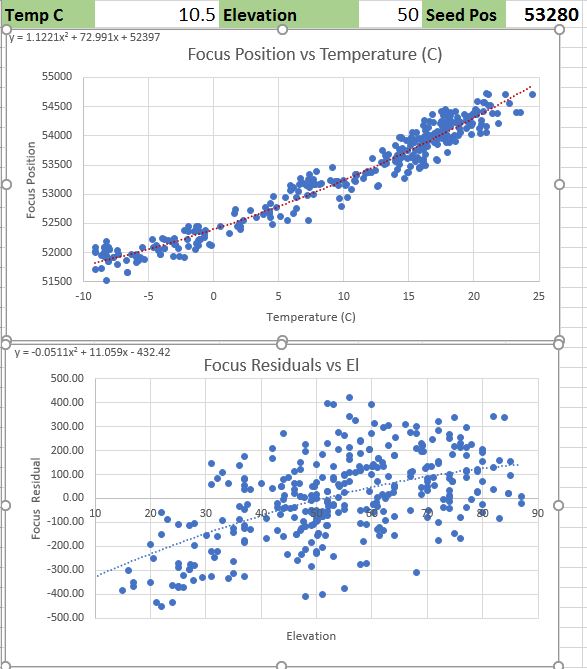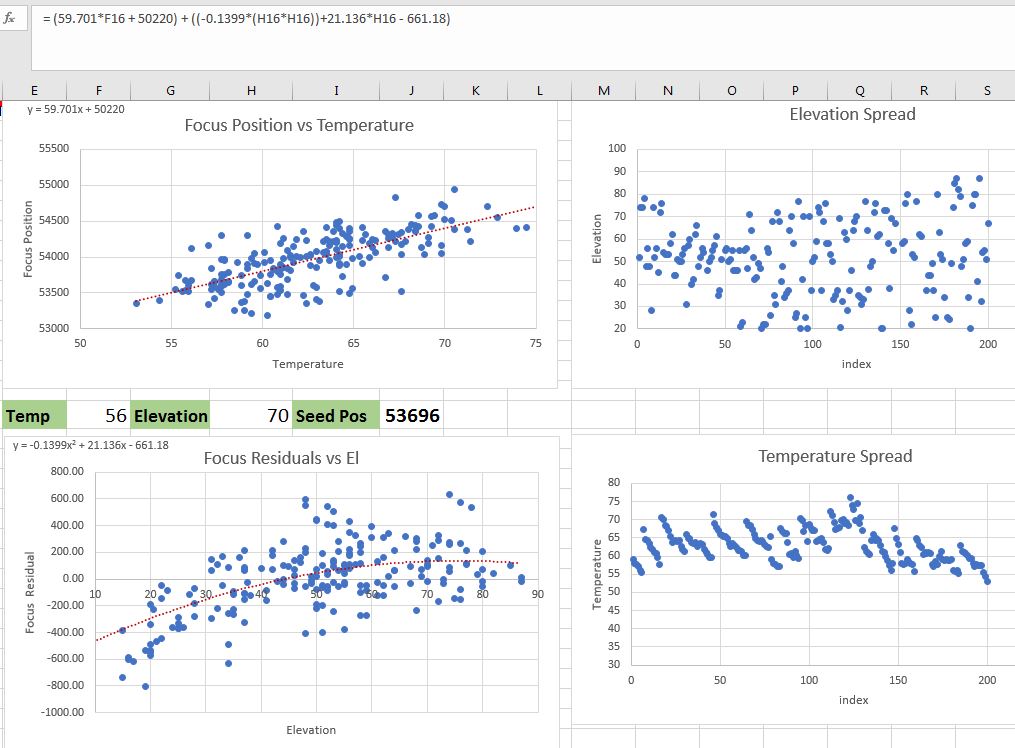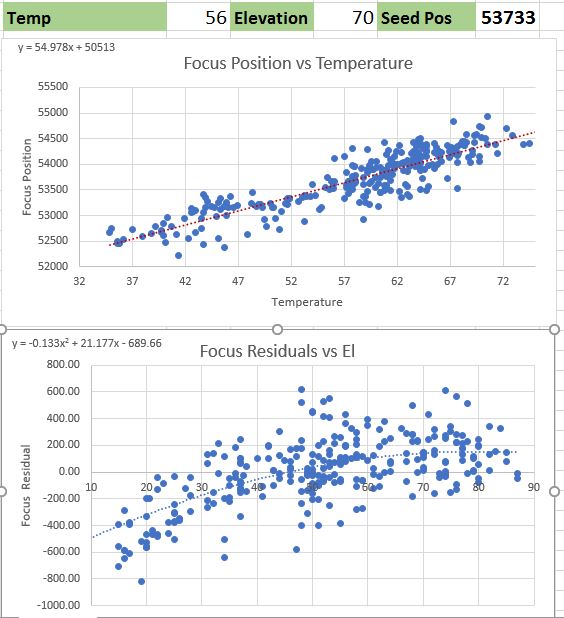INDI Library v2.0.7 is Released (01 Apr 2024)
Bi-monthly release with minor bug fixes and improvements
Temperature and Altitude (residual) focus compensation
Temperature and Altitude (residual) focus compensation was created by Doug S
autofocus log (located in .local/share/kstars/focuslogs/):
date, time, position, temperature, filter, HFR, altitude
2020-09-01, 22:35:46, 50100, 15.0, Red, 1.692, 37.5
kstars log has a similar, but different formatted entry:
Autofocus values: position, 50100 , temperature, 15.0 , filter, "Red" , HFR, 1.69168 , altitude, 37.4758
The prior version of the log entry already facilitated plotting temperatures against focuser positions. The new code provides users with info needed to find the altitude residuals trend.
For those that don't know how to process the data (but want to), do the following: (Note that your focuser should be well behaved...no major slipping or out-of-control backlash or your trendline functions will be suspect)
a. Import the autofocus log into your favorite spreadsheet or charting app and plot all temperatures against corresponding focuser positions. Set a linear or quadratic trendline for the data and display the equation.
b. Create a new column that subtracts the above equation from each focuser position (on the same row). This is the residual of the measurement after factoring the temperature trend.
c. Plot the residuals column (from b above) against altitudes, set a trendline, and display that equation. This is the elevation residual function.
You can now calculate your autofocus "seed" position for any temperature and elevation. Add the two functions together using the input temperature and elevation. I've provided a sample spreadsheet clip below that hopefully helps folks understand the setup a bit better. The top line shows the seed position calc for my gear (partial data). In my case, indications are that I must adjust my focuser ~75 counts for each degree (C) change, and also ~21 counts (+/-) for each degree change in target altitude angle. Running the focuser seed calc after a slew and setting the focuser position to the seed before running autofocus allows tighter parameters, keeps autofocus runs short, and increases successful outcomes. Automation (future) is certainly possible, but for now, I hope this info helps folks get a better handle on focus performance. Cheers, Doug
Please Log in or Create an account to join the conversation.
- Jerry Black
-
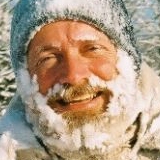
- Offline
- Elite Member
-

- Posts: 460
- Thank you received: 69
Replied by Jerry Black on topic Temperature and Elevation focus compensation
Thanks
Please Log in or Create an account to join the conversation.
Replied by Doug S on topic Temperature and Elevation focus compensation
Please Log in or Create an account to join the conversation.
- Andrew Burwell
-
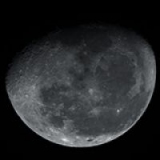
- Offline
- Platinum Member
-

- Posts: 527
- Thank you received: 139
Replied by Andrew Burwell on topic Temperature and Elevation focus compensation
Please Log in or Create an account to join the conversation.
Replied by Andrew on topic Temperature and Elevation focus compensation
Please Log in or Create an account to join the conversation.
Replied by Doug S on topic Temperature and Elevation focus compensation
Please Log in or Create an account to join the conversation.
Replied by Doug S on topic Temperature and Elevation focus compensation
Please Log in or Create an account to join the conversation.
Replied by Andrew on topic Temperature and Elevation focus compensation
Please Log in or Create an account to join the conversation.
Replied by Doug S on topic Temperature and Elevation focus compensation
Edit: I've updated the charts for my setup (updated in the OP). There are ~300 autofocus sequences captured from July to Nov. Based on the results, I've altered the elevation residual function to a 2nd order poly (still not quite powerful enough...but sufficient). The temperature function dominates (5 degree change drives ~400 focuser count shift), while elevations above ~40 degrees do not really drive noticeable offsets. Observations below 40 degrees elevation do drive significant offsets. Your gear & results will differ, but the trends will likely be similar.
Cheers, Doug
Please Log in or Create an account to join the conversation.
Replied by Giles on topic Temperature and Elevation focus compensation
It's excellent as it is, but always thinking of better. I know the team are making loads of commits to get 3.5.0 stable, but this would make a worthy future feature.
Please Log in or Create an account to join the conversation.
Replied by Doug S on topic Temperature and Elevation focus compensation
I'll make the bold statement that temperature and elevation focus compensation could benefit everyone who takes the time to characterize their gear (via the existing focus log entries). This is especially true for faster focal ratio setups. I've seen the difference, and it's appreciable. Updating the focus position (seed) before starting autofocus always results in a minimized,symmetric V curve. I no longer worry about donuts or run-away anomalies, and focus updates are more efficient. For scheduled or remote/unattended observations, I would think this would especially add robustness and less overhead.
So, I'd like to ask if there's someone from the core developers who might want to partner with me to resolve final details, and modify the focus code for a future release. I've never been a GUI developer. I can definitely drive requirements and help with coefficients file logic and seed update logic. The GUI work should be minimal (enable switch for compensation seed auto-update). A minimalist approach now could be followed later with more sophisticated automation. Comments? Any takers? Thanks, Doug
Please Log in or Create an account to join the conversation.
- Brian Davis
-
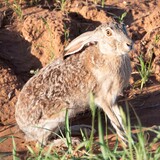
- Offline
- Junior Member
-

- Posts: 33
- Thank you received: 15
Replied by Brian Davis on topic Temperature and Elevation focus compensation
Please Log in or Create an account to join the conversation.

